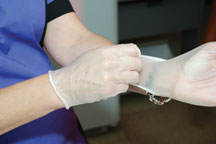
Antimicrobial Medical Gloves
The impact of health care related infections is a global concern, and hands are a leading means of direct or indirect transport of infectious microorganisms. A task group in Subcommittee D11.40 on Consumer Rubber Products has begun to develop standards focused on preventing that transfer through the use of antimicrobial agents on gloves. D11.40 is part of ASTM International Committee D11 on Rubber.
WK27438
- Antimicrobial efficacy on the surface of medical gloves;
- Efficacy of medical gloves to reduce the number of microorganisms reaching the wearer during a barrier breach;
- Microbial transfer from one surface to another via a medical glove; and
- Accelerated aging of antimicrobial medical gloves.
"If gloves could kill microorganisms rapidly after contacting them, one means of microbial transport to another surface, patient or even to the glove wearer would be addressed," says Truscott, who is the chair of the D11.40.19, the Antimicrobial Medical Glove Task Group.Truscott says that the primary users of WK27438 and other proposed standards that may be developed by the task group will be glove manufacturers, antimicrobial suppliers, contract test laboratories and government agencies. In addition, purchasers, glove selection committees, infection preventionists and end users will benefit from the standardized data produced as a result of performing standardized tests on gloves under purchase or use consideration. All interested parties are encouraged to join in the standards developing activities of D11.40.
CONTACT Technical Information: Wava Truscott, Kimberly-Clark Health Care • Roswell, Ga. • Phone: 770-587-8805 • E-mail: wava.truscott@kcc.com O ASTM Staff: Joe Koury • Phone: 610-832-9804 • E-mail: jkoury@astm.org O Upcoming Meeting: June 6-10 • June Committee Week • St. Louis, Mo.
 SN Home
SN Home Archive
Archive Advertisers
Advertisers Masthead
Masthead RateCard
RateCard Subscribe
Subscribe Email Editor
Email Editor